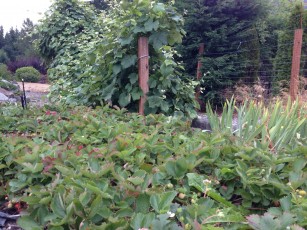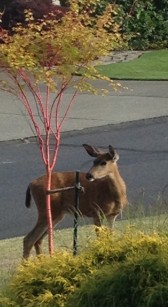 Last Christmas I gave my sister a Beni Kawa Japanese maple. This tree sports even brighter red bark in the winter than the more familiar Coral Bark maple. She recently sent me a picture of a deer standing right next to it and looking? longingly at it?s next meal. Her tree wasn?t nibbled that day but I was anxious to visit Fox Island where she lives in the Pacific Northwest to check on it for my self.
Last Christmas I gave my sister a Beni Kawa Japanese maple. This tree sports even brighter red bark in the winter than the more familiar Coral Bark maple. She recently sent me a picture of a deer standing right next to it and looking? longingly at it?s next meal. Her tree wasn?t nibbled that day but I was anxious to visit Fox Island where she lives in the Pacific Northwest to check on it for my self.
The morning after I arrived I heard the neighbors next door outside in their garden chatting. I have seen their vegetable garden from outside the fence as I drove by and was curious what they had growing in there. I introduced myself and was offered fresh picked blueberries, raspberries and strawberries. ?Come by after breakfast and we?ll give you a tour?, they said. I could hardly wait.
The front of Bob and Bev?s corner lot is landscaped with perennials, flowering trees and shrubs. Everything on the property is grown organically, they told me. ?The weeds can really get out of hand up here with all the rain?, they  lamented. The back garden containing the edibles is fenced but the front is open to the local deer population. A massive Limelight hydrangea paniculata dominates the entry. Covered with hundreds of lime green blooms that will turn pink in the fall, Bob told me he sprays it weekly with Liquid Fence deer repellent.
lamented. The back garden containing the edibles is fenced but the front is open to the local deer population. A massive Limelight hydrangea paniculata dominates the entry. Covered with hundreds of lime green blooms that will turn pink in the fall, Bob told me he sprays it weekly with Liquid Fence deer repellent.
White coneflower, dahlia, crocosmia, hosta and gladiola are just a few of the perennials in their landscape. Bob and Bev mix native plants with other plants they like. Native Oregon grape 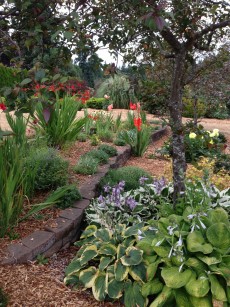 ground cover and manzanita cover the sloping bank along with a small stand of vinca minor that is well behaved. Bev does wish she hadn?t planted the bugloss under the flowering plum but say?s the little blue forget-me-not flowers each spring are worth the effort it takes to keep it in check.
ground cover and manzanita cover the sloping bank along with a small stand of vinca minor that is well behaved. Bev does wish she hadn?t planted the bugloss under the flowering plum but say?s the little blue forget-me-not flowers each spring are worth the effort it takes to keep it in check.
In the back, protected by a perimeter deer fence is where the edibles live.
On one side of the yard is a 40 foot stream Bob designed and built himself. Along the curving bank they have planted Oregon grape, salal, kninnikinnick manzanita and snowberry. Woolly thyme and black pussy willow also grow alongside. Wild birds love bathing in the stream. Bob used the leftover soil and rock from the stream project to construct a 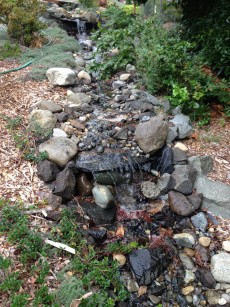 mound for overbearing strawberries.
mound for overbearing strawberries.
Another bed of strawberries is still producing. This one is built from timbers and amended soil from compost Bob and Bev make themselves.
The raspberry crop was great this year, Bev said. I had tasted a few and she wasn?t exaggerating.
They have an attached greenhouse, that Bob designed and built. ?Overbuilt?, they both laughed.? Bob?s an engineer and couldn?t help but design thermal windows, fans, vents and a heating system that allows them to grow back-up tomatoes in the summer and to start seeds in the winter. The double pane windows keeps the temperature inside in the 40?s without the heat having to kick on. A meyer lemon grew lush in the corner covered with blossoms and fruit.
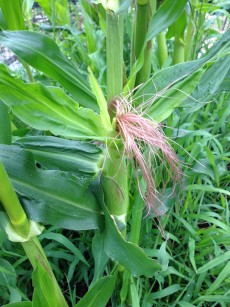 Bob was advised he could never grow corn in the Pacific Northwest but being from the midwest where corn is king he had to try. Their crop was just setting ears at 4 feet and will grow to 7 feet tall by the end of summer. ?They?re delicious?, he told me.
Bob was advised he could never grow corn in the Pacific Northwest but being from the midwest where corn is king he had to try. Their crop was just setting ears at 4 feet and will grow to 7 feet tall by the end of summer. ?They?re delicious?, he told me.
All bare soil in this organic garden is covered with bark chips. Bev told me she listens for a chipper in the neighborhood and tells them where to drop it off. They swear by this type of mulch. ?Like gold?, Bev laughs.
Bob and Bev make gardening in the Pacific Northwest look easy. Their garden is the result of many hours of pleasant work and it shows.

